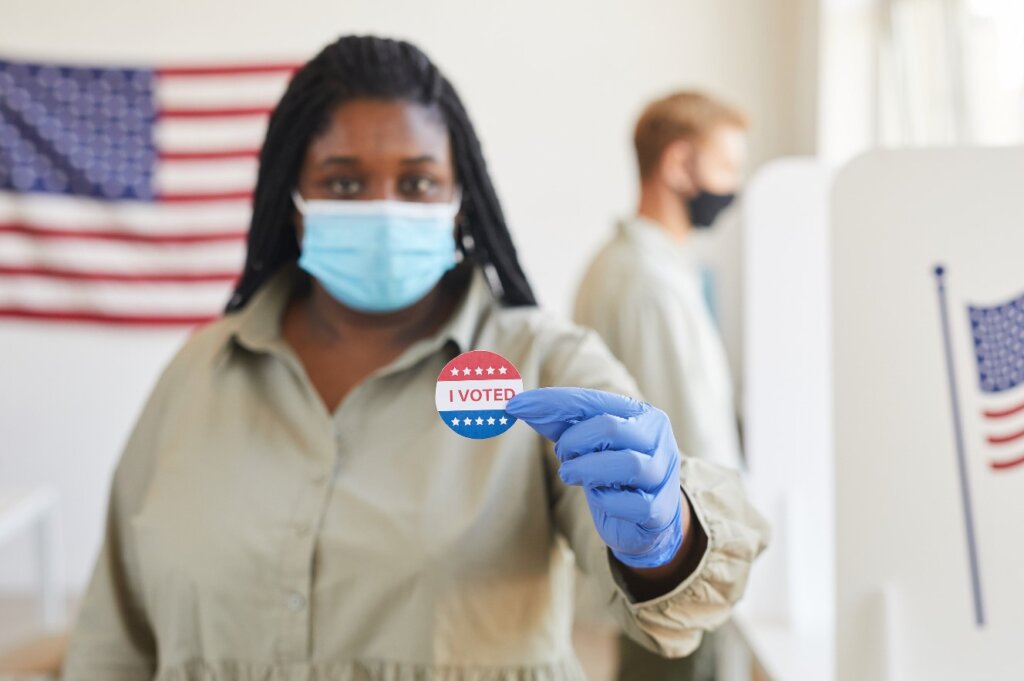Despite many Cassandra-like warnings of nightmare scenarios, the 2020 elections were an institutional success. Deserving credit are voters who participated in large numbers, election officials who adapted to the realities of conducting an election during a pandemic, and judges who balanced vague and sometimes conflicting constitutional principles and legislative provisions in a series of hotly contested cases. Yet, the concerns raised during the past several months from across the political spectrum deserve the considered attention of legislators and policymakers before they may morph into more serious problems that indeed do delegitimize the conduct of future elections.
An estimated 155 million of the 230 million eligible U.S. citizens cast ballots in 2020, representing the highest turnout percentage in a presidential election since 1900. Election officials across all 50 states, responding effectively to a raging pandemic, implemented major changes in how and when individuals could vote. Ultimately, more than 100 million voters cast their ballots before election day, either through early in-person voting or mail-in voting, and the expected long waits at polling sites on election day, for the most part, did not materialize.
The counting of votes also proceeded in proper fashion. As expected, states like Wisconsin and Pennsylvania, where the processing of ballots could not begin until election day, required several days after November 3 to complete their state-wide counts. However, by the Saturday after election day, all the networks had projected Joe Biden as the president-elect. Subsequent recounts in states where the difference between Biden and Donald Trump was less than half of one percent caused minimal shifts in vote totals and all states were able to certify their election results by early December.
Having observed many elections overseas, Trump’s refusal to concede and his presentation of a litany of complaints was not all that surprising. Losing candidates, albeit mostly in fragile democracies, frequently charge that the electoral abuses committed by their opponents warrant an invalidation of the election results. While each circumstance is unique, the concerns generally include allegations of pre-election misuse of government resources, intimidation of voters before and on election day, and the manipulation of the vote count at the polling site and during the tabulation process.
Based on their detailed listing of irregularities and misdeeds, losing candidates expect the international observers present in the country to issue a critical assessment of the electoral process and thereby delegitimize their opponent’s claim of victory both domestically and within the international community. For their part, the international observers, without belittling the severity of the issues raised or ignoring them in post-election statements, generally counsel the aggrieved candidate to utilize the prescribed legal processes, usually the courts, to adjudicate their complaints.
This advice is not the answer losing candidates want to hear. They believe the courts are dominated by supporters of their opponent, often the incumbent chief executive, and incapable of reaching an independent judgment. More fundamentally, they appreciate that even the most neutral courts are reluctant to invalidate an election unless there is a strong evidentiary showing of electoral fraud that impacted directly the margin of victory. Thus, even if courts acknowledge the validity of their complaints about pre-election abuses, the courts are unlikely to reverse the previously announced outcome unless there is clear and convincing proof that the actual vote count was manipulated to the detriment of the losing candidate.
With its 230-year tradition of periodic elections and constitutional transfers of power, the United States can hardly be categorized as a fragile democracy. Moreover, Trump is the incumbent, not an opposition insurgent, and it is he who claims to be the aggrieved party, even as his own appointees, including the attorney general and the head of the Cyber Intelligence Security Agency (CISA), dismiss his complaints as lacking any factual basis. Adding to the ironies, the judges that he selected for the federal judiciary, as well as their state counterparts, have had little trouble expeditiously rejecting the cases filed as lacking an evidentiary base and as unfounded in law.
In the months preceding the 2020 elections, many experts wondered whether the much-venerated independence and institutionalist orientation of U.S. courts would prevail. They feared that court decisions would not be explicable by neutral principles but by the political affiliation of the judge or his nominator. Pre-election litigation added to the concerns.
One fault line involved the extent to which courts could be used to expand access to the ballot box during a pandemic. At the federal level, the Purcell principle (see Purcell v. Gonzalez, 549 U.S. 1 (2006) counseled against judicial interference in changing election rules during the period just prior to an election because doing so could confuse voters and create problems for officials administering the election. Application of Purcell by the Supreme Court and various federal courts of appeals resulted in the reversal of several lower court decisions, which had liberalized rules regarding mail-in ballot procedures, among other issues.
This line of cases serves as cautionary precedents for those seeking to vindicate voting rights through the courts. However, despite fears to the contrary, these cases had limited practical impact on voter access given the broad expansion of mail-in ballot and early in-person voting opportunities that were in fact adopted by state legislatures and election officials across the country in response to the pandemic. Combined with the reality of a motivated electorate and a sophisticated voter education effort, the result was an extraordinarily high voter turnout.
A second fault line involved the interpretation of Article 1, Section 4 of the Constitution, which provides that the “Times, Places and Manner of holding Elections for Senators and Representatives, shall be prescribed in each State by the Legislature thereof.” The question posed in several cases was whether this provision represents an exclusive grant of authority to the state legislatures for regulating elections, or whether courts can modify the legislature’s enactments to promote compliance with other constitutional mandates. For example, courts had relied on an explicit or implicit right to vote to justify the extension of the deadline for when mail-in ballots had to physically arrive at the elections office.
Justice Roberts, who provided the decisive vote in cases from Pennsylvania and Wisconsin, explained his reasoning as follows: “While the Pennsylvania applications implicated the authority of state courts to apply their own constitutions to election regulations, this case involves federal intrusion on state lawmaking processes. Different bodies of law and different precedents govern these two situations and require, in these particular circumstances, that we allow the modification of election rules in Pennsylvania but not Wisconsin.” Thus, by his reasoning, state courts could interpret state election legislation, but federal courts were limited in their ability to act in a similar manner.
“While the Pennsylvania applications implicated the authority of state courts to apply their own constitutions to election regulations, this case involves federal intrusion on state lawmaking processes. Different bodies of law and different precedents govern these two situations and require, in these particular circumstances, that we allow the modification of election rules in Pennsylvania but not Wisconsin.”
The more conservative justices on the Court disagreed with Roberts and sought to establish as a firm constitutional principle that only state legislatures can modify election laws. The elevation of Justice Barrett may shift the Court’s balance on this critical issue, but the Pennsylvania case that might have offered a further opportunity for review proved moot when the number of mail-in ballots arriving after the legislative mandated deadline in Pennsylvania were considerably less than the margin of victory between Biden and Trump in the state. And on December 8, the Court unanimously denied a request brought by Republican legislators to invalidate the election results in Pennsylvania because the legislation authorizing mail-in balloting violated the Pennsylvania constitution.
Trump’s rhetoric regarding the importance of confirming Justice Barrett prior to the elections reinforced the notion that the Supreme Court might play a determinative role in choosing the next president. However, in their post-election handling of the many cases filed by Trump’s attorney following the election, state and federal courts across the country demonstrated their commitment to the rule of law. The courts unanimously concluded that Trump’s team had not presented evidence to support invalidation of the election. Moreover, applying the doctrine of laches, several courts rejected challenges to laws adopted well before the elections, which should have been filed prior to voters casting their ballots. Taken together, the court decisions reflected a strong aversion toward disenfranchising eligible voters who had cast their ballots in good faith, even where the voter or the election official may not have followed the prescribed procedures in all details.
The Third Circuit Court of Appeals in Trump et al v. Secretary of the Commonwealth of Pennsylvania et al exemplifies the judicial response to the challenges posed. The petitioners sought to throw out millions of ballots on the ground that some counties restricted poll watchers and other counties let voters fix technical defects in their mail-in ballots. At the outset, the court noted: “Charges of unfairness are serious. But calling an election unfair does not make it so. Charges require specific allegations and then proof. We have neither here.” And in its closing comments, the court offered this rebuke to the effort to undermine the role of voters in the selection of the President: “Voters, not lawyers, choose the President. Ballots, not briefs, decide elections.”
“Charges of unfairness are serious. But calling an election unfair does not make it so. Charges require specific allegations and then proof. We have neither here.”
If nothing else, the 2020 experience cries out for a holistic review of the U.S. electoral process. To avoid controversies in the future, state legislation should institutionalize practices utilized during the pandemic to adopt voter friendly, fraud-proof mechanisms for casting ballots. However, this will require continued political mobilization at the state level to counter the inevitable backlash by those candidates and parties negatively affected by the high turnouts engendered by the availability of various options.
Second, 2020 highlighted the critical roles played by senior election officials in each state. Trump’s criticisms of election officials in Georgia and Arizona notwithstanding, no election official this year has been accused of “tipping the scales” to enhance the prospects of a candidate with whom he or she is politically affiliated as has happened in the past. Nonetheless, the United States remains an anomaly among democracies across the globe in selecting its chief election official through a partisan election process. At the very least, state legislatures should adopt conflict of interest rules to guide the actions of chief election officials; specifically, these officials should be precluded from actively supporting candidates for elected office and should recuse themselves from participating in decisions that could affect their candidacies for elected office.
Finally, at the federal level, Congress should actively debate the multiple electoral reforms proposals that will emerge from reviews of the 2020 election process. The more far-reaching reforms will seek to abolish or adjust the historic vestige that is the electoral college and to curb the obscene role that private money plays in the U.S. election system. More narrowly and perhaps more politically realistic, Congress should revise the Electoral Count Act of 1887, whose textual ambiguities was the source of many nightmare scenarios proffered by election law experts, should strengthen the Cyber Intelligence Security Agency, which provided confidence to the electorate that the election infrastructure was safe from domestic and foreign hackers, and should finance further upgrades in election infrastructure to ensure that the U.S. systems remain capable of resisting future attacks.
More narrowly and perhaps more politically realistic, Congress should revise the Electoral Count Act of 1887, whose textual ambiguities was the source of many nightmare scenarios proffered by election law experts
Improving and securing our electoral process remains as much of a challenge today as it did at the outset of the Republic. Hence, even as we celebrate the successful role our institutions played in 2020, we must avoid complacency and remain ever-vigilant. The line between maintaining democratic norms and falling into the fragile democracy abyss is less wide than we imagined.











